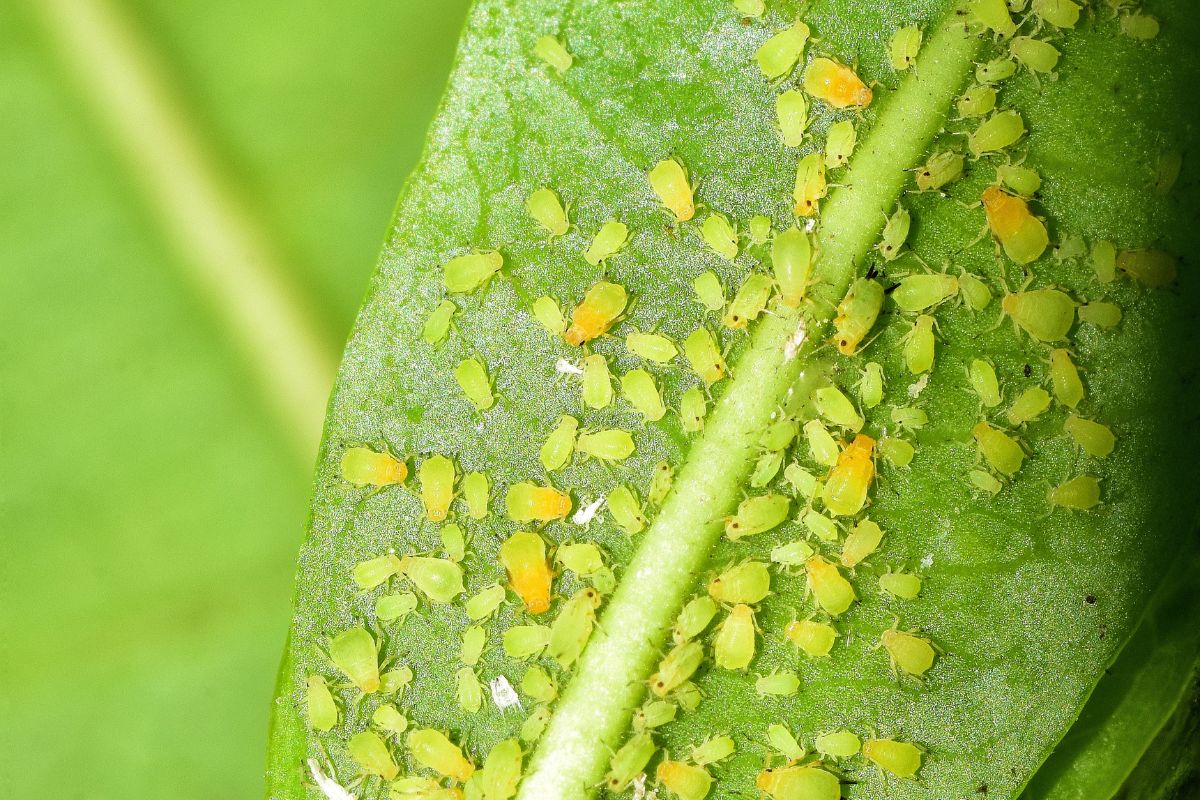News

News
Aphids: Tiny Pests that Can Wreak Havoc on Your Garden
Aphids can be found on most plants in landscapes and gardens. With more than 1300 species in North America alone, these small insects are among the most common garden pests.
Aphids feed on plant sap in stems, leaves, and roots, and while they rarely kill plants, they can cause damage like twisted, curled, or yellowed leaves. A severe infestation may result in stunted or dead shoots or poor plant growth.
Part of the challenge of trying to control aphids is their ability to reproduce billions of offspring in a single year, which enables populations to quickly grow out of control. Pesticides and insecticides like pyrethroids, organophosphates, carbamates, cyclodienes, and neonicotinoids have been used to control these insects – but they can also backfire by eliminating natural predators, potentially increasing aphid activity, and contaminating the soil, leading to broader environmental harm. However, growers can successfully control and eliminate aphids and with all-natural options.
In this article, you’ll learn more about aphids, how they cause damage, why an established aphid population is so difficult to manage, and how to naturally fight these garden intruders.
What are Aphids?
Aphids are insects that range from 1/16 to 1/8 inch with long legs and antennae. Mature aphids may or may not have wings. Most species sport a pair of cornicles – tubelike structures that project backward from their hind end.
Depending on the variety, they may be green, red, black or brown, and some types of aphids appear wooly or waxy due to the secretion of a waxy white or gray substance over their body.
These pear-shaped, soft-bodied insects are very active in the summer months, seeking out developing flowers, twigs, stems, roots, or shoots, the underside of leaves or unopened flower buds for their sustenance. They are often seen clustering in dense groups on new growth.
Aphids target popular garden plants including beans, cucumbers, melons, potatoes, squash, and tomatoes. They also feed on some trees and shrubs, like ash, birch, and maple trees and viburnum and hydrangea bushes, among many others. Virtually every plant has at least one aphid species that attacks it.
How Aphids Harm Plants
Using piercing, needle-like mouthparts to suck sap from new growth, aphids rob the host of vital nutrition, causing damage to the host plant.
They also excrete honeydew, a sugary waste product. This liquid drips onto foliage and creates perfect conditions for black, sooty molds to develop. While the fungi itself does not directly damage the host plant, it blocks sunlight on the leaves, interrupting photosynthesis: a disruption that causes plant stress that can lead to premature leaf drop and slowed plant growth.
The honeydew secretions attract ants who feed on them and a large ant population can indicate an aphid infestation. Interestingly, ants not only ingest the honeydew but may tend or care for aphids in return and will defend the insects from natural enemies.
Aphids also cause damage because they are vectors and can spread some of the most lethal plant viruses. Among many viruses, aphids spread the potato leafroll virus, which can devastate an entire potato crop, the cucumber mosaic virus, and the polerovirus, both of which can reduce crop yield. These insects remain invective and able to spread a virus for anywhere from 7 days to the rest of their lives.
Why are Aphids So Resilient?
The aphid’s lifecycle makes it a challenge to manage. While the insects may only live 1-2 weeks, they produce multiple generations a year. Female aphids do not need to mate to give birth to offspring, called nymphs, and can produce as many as 12 offspring a day and up to 80 nymphs per week.
The alarming reproduction rate is due to a phenomenon known as parthenogenesis, or the “telescoping of generations.” Female aphids’ eggs start to develop long before birth, which means a newborn nymph is already carrying the developing embryos of the next two generations to follow. Many species of aphids can develop from a newborn aphid to a reproducing adult in roughly a week.
Beyond reproduction, aphids easily adapt to their environments and develop resilience to various environmental conditions, including drought and heat stress. They also adapt as their host plants evolve, suggesting that, as climate conditions change, aphids will keep pace.
This adaptability makes it a challenge to treat these insects with pesticides because many varieties of aphids quickly develop pesticide resistance. The use of chemical compounds may actually exacerbate the problem. If an aphid is simply probing a leaf and senses the host plant is no longer suitable, it will relocate to find another place to feed. This can actively spur additional movement, causing more viral spread and leading to more damage.
The aphid’s reproduction rates outpace the lifecycle of its natural predators, including lacewings, beetles, ladybugs, and flies. While insecticides may reduce aphids, they will also reduce predator populations, resulting in increased pest outbreaks, while contaminating soil, water, and other vegetation, and degrading the earth, which is why natural pest management is so important.
How to Naturally Combat Aphids
It is far easier to prevent an infestation than to treat one, which calls for preventative measures. Integrated pest management, or IPM, is a natural way to manage aphids in the garden. Practices like companion planting – alternating complementary plants within the same rows or patches – can help confuse these insects, lowering the chance of an infestation.
IPM also involves the premise of biological control: using nature against itself. Although resident predator populations can maintain aphids at low levels, aphids’ reproduction rates call for increased numbers of natural enemies. As predators are attracted to a food source, farmscaping, or adding foliage that attracts predators, is helpful. Many herbs, flowering plants, and row crops attract natural enemies as well as insect pollinators like bees and butterflies. Note that the delay between when the aphids arrive and when their predators appear enables additional aphid population growth.
Using water to attack aphid populations is another effective IPM practice that does wonders to manage these insects. A strong stream of water can knock aphids – and honeydew secretions – off the plant.
Combine the practice of water spraying with the use of an all-natural product to manage aphid populations. GrowSafe is a biodegradable formula made from food-grade corn, soybean, sunflower and coconut oils and citric acid. Thoroughly coating your plants with GrowSafe suffocates aphids on contact and provides a barrier that prevents more insects from feeding on your plants.
The product is safe for the pollinators and beneficial insects that come into contact with treated plants, and treatment will not change the smell or taste of herbs and botanicals, fruits, or vegetables. Unlike neem oil, GrowSafe is non-toxic to fish and other aquatic life and does not cause skin irritation for those who come into contact with it. Plus, GrowSafe is safe to use at any stage of growth.
To treat an active aphid infestation, use a good sprayer to hose down your plants and knock the aphids off, and follow up with a thorough application of GrowSafe, covering both sides of the leaves. Repeat this 3 times with 3 days in between applications.
Once the outbreak is under control, apply GrowSafe to plant leaves every 6-10 days as part of your maintenance regimen to keep aphids in check.
Final Thoughts
Whether your garden is indoors, outdoors, or in a greenhouse, aphids can be a persistent problem. The key to treating and preventing aphids in any environment is being proactive:
● Watch for early signs that these insects are targeting your plants: sticky residue on your foliage, curled or yellowing leaves, black fungi, or active ant colonies. These are telltale signs that an aphid infestation could be underway.
● Treat these insects as soon as you notice them.
● Regularly spray GrowSafe for ongoing prevention.
Combining applications of all-natural GrowSafe as part of your IPM strategy is a powerful way to treat existing aphids and prevent new ones from finding a home in your foliage.
